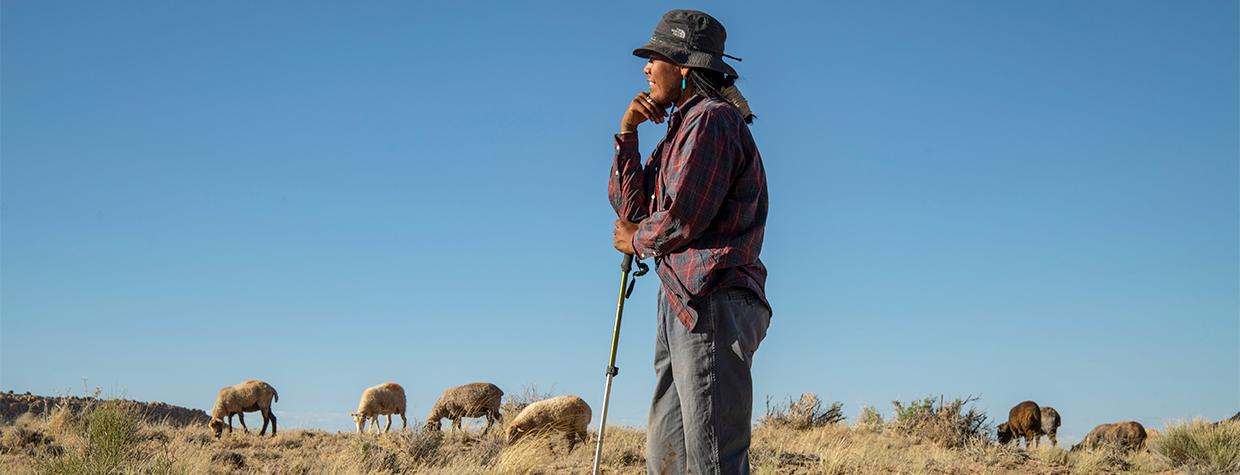It was a cool, calm morning in June 1972. The sun had not yet risen behind the mesas that sit to the east of one of my family’s many homesteads on the Navajo Nation, a place we call Tsézhin Nideeshgiizhí. My maternal uncles Christopher Kady and one of his younger brothers, Irvin Kady, were preparing to herd just over 100 head of sheep and goats through the southeastern part of Utah, across U.S. Route 160 and to the very top of the Carrizo Mountains near Teec Nos Pos, Arizona.
With the help of their father, George Kady, one of my late maternal grandmother’s five brothers, they loaded up the young lambs and kids, along with the older and slow ewes, that would hitch a ride to the final destination. After filling their stomachs with leftover tortillas and maybe some slivers of salted bacon, they started the approximately 22-mile trek from the winter homestead to the summer sheep camp atop the mountains. The two — Christopher, only 15 years old, and Irvin, who was just 14 — started their journey not long after 7 a.m. They left with nothing but the clothes on their backs, a bottle of soda each in case they grew thirsty along the way, and a handful of instructions from their dad.
Throughout my life, I have heard many stories about my family, our livestock, our homesteads, and the ins and outs of life in the Four Corners area, but this was one story I hadn’t heard until recently, 50 years after it happened.
As a child, I grew up herding sheep with my family. And unlike most children across the country, who at the end of the school year were eager to begin their summer breaks in lands and places far from their homes, I looked forward to our trips up the mountains. My fondest and most vivid childhood memories are atop the Carrizos. It was where I learned to build a fire from scratch, how to puncture juniper berry seeds and how to cut the throat of a sheep when butchering — something my late grandmother insisted I learn.
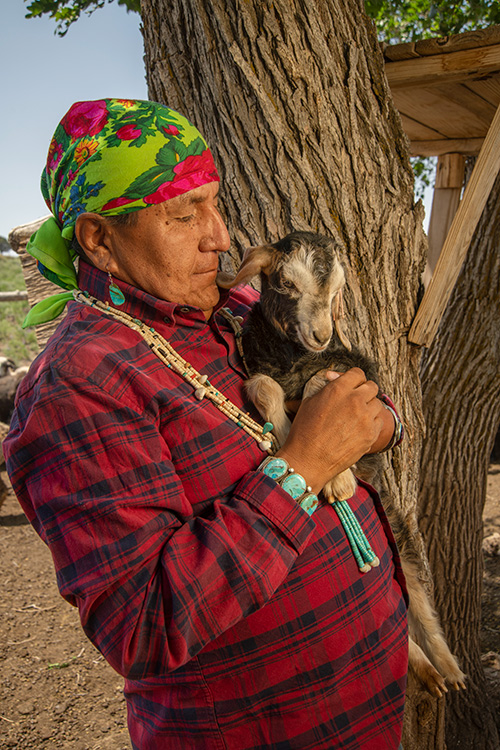
While I have many fond memories tied to the sheep and our sheep camp, I never thought much about the practice of moving our family up the mountains every summer and back down for the winter, or about its significance. Nor had I thought much about how fewer and fewer Diné continue to do the same. Why do we, as a family, find it important to continue this practice? I wondered. And what does it mean to keep it going? I yet again found myself back on the reservation, looking for answers about a long family tradition that has become a nearly extinct practice.
To learn more about the last time the flock trailed from Utah to Arizona 50 years ago, I sat down with my uncle Christopher. While I had heard many stories about our various summer and winter camps from my mother, my late grandmother Mary Kady Clah and other family members, I knew very little about the specifics of trailing.
I learned that my great-grandfather Hastiin Gonna Y é˛ é˛ Biye’ Kady Wolyéhígíí — who was a well-known horseman in the Four Corners area, among other things — was assigned a grazing permit in April 1944 at the Arizona-Utah border northwest of Teec Nos Pos. The land he was assigned is about 2 miles wide and 6 miles long, and it runs from the state line to the San Juan River.
It was there that my late grandmother Shimá, as we called her, and her siblings grew up herding sheep and goats in the fall, winter and spring before moving the sheep to the top of the Carrizos. It was also where my great-grandfather captured and tamed wild horses that would eventually become part of our family.
While herding the livestock, Shimá and her siblings had many options and places to explore. They herded the sheep along ridges and down washes, and they took them to the river to hydrate. Although it was far from basic amenities that life outside the reservation had to offer, it was the perfect place to have livestock and raise a family.
“You could take them anywhere you wanted,” Christopher says. “Our homestead was not in specific locations year-round. A lot of folks out there in Red Mesa [and] Teec, they didn’t have an area that we had. We could move from a winter camp, spring camp, to summer camp. It was kind of unique for us.”
While the herding was initially left to Shimá and her siblings, their children eventually learned and participated. My mother often spent her breaks from boarding school at one of the sheep camps near the river, herding sheep with her aunt, cousins and grandfather Kady. She remembers a time when she was left with Kady at a spring camp. Around dinnertime, he left the hogan without saying a word and came back a short time later, carrying a rabbit by its feet. She watched and learned to butcher a rabbit that night. And after dinner, they lay on the hogan floor, looking up through the hole at the top, where the stovepipe ran, and watched the stars.
At another camp closer to the river, my mother remembers the adults separating the lambs and kids from their mothers. She would sneak into the pen holding the kids and lambs, sit in the center of the corral and wait for them to come up to her to nibble on her hair and ears.
The young ones’ lessons weren’t explicit. They were expected to pay attention to everything happening around them, which was how so many of them, including Christopher, caught on. He says from the time they could speak and understand, they knew the importance of herding sheep. “It was a way of life,” he says. “We had animals, and we had to care for them.”
Where the family decided to set up their camps was contingent on the foliage, the time of year and the needs of the flock. The family uprooted and moved often because they understood the importance of having livestock and what it meant for their livelihood, but also for their culture.
To the Navajo people, the sheep is life. Sheep have a long history of providing for us, and in more ways than as food. It is said that when one has sheep, one cannot go hungry, and herding sheep keeps people active and physically fit. Sheep keep the ecology thriving, making them part of the deeply rooted relationship the Diné have with the land.
“Dibé éí binahj i˛’ kéyah bee nidziil, éí binahj i˛’ kéyah hól ó˛, éí binahj i˛’ ” (“The land is strong because of the sheep, the sheep are the reason we have land, because of the land and the sheep”), my uncle Roy Kady says. “We’re able to still walk here; we’re able to still plant here. Sheep are a big part of that.”
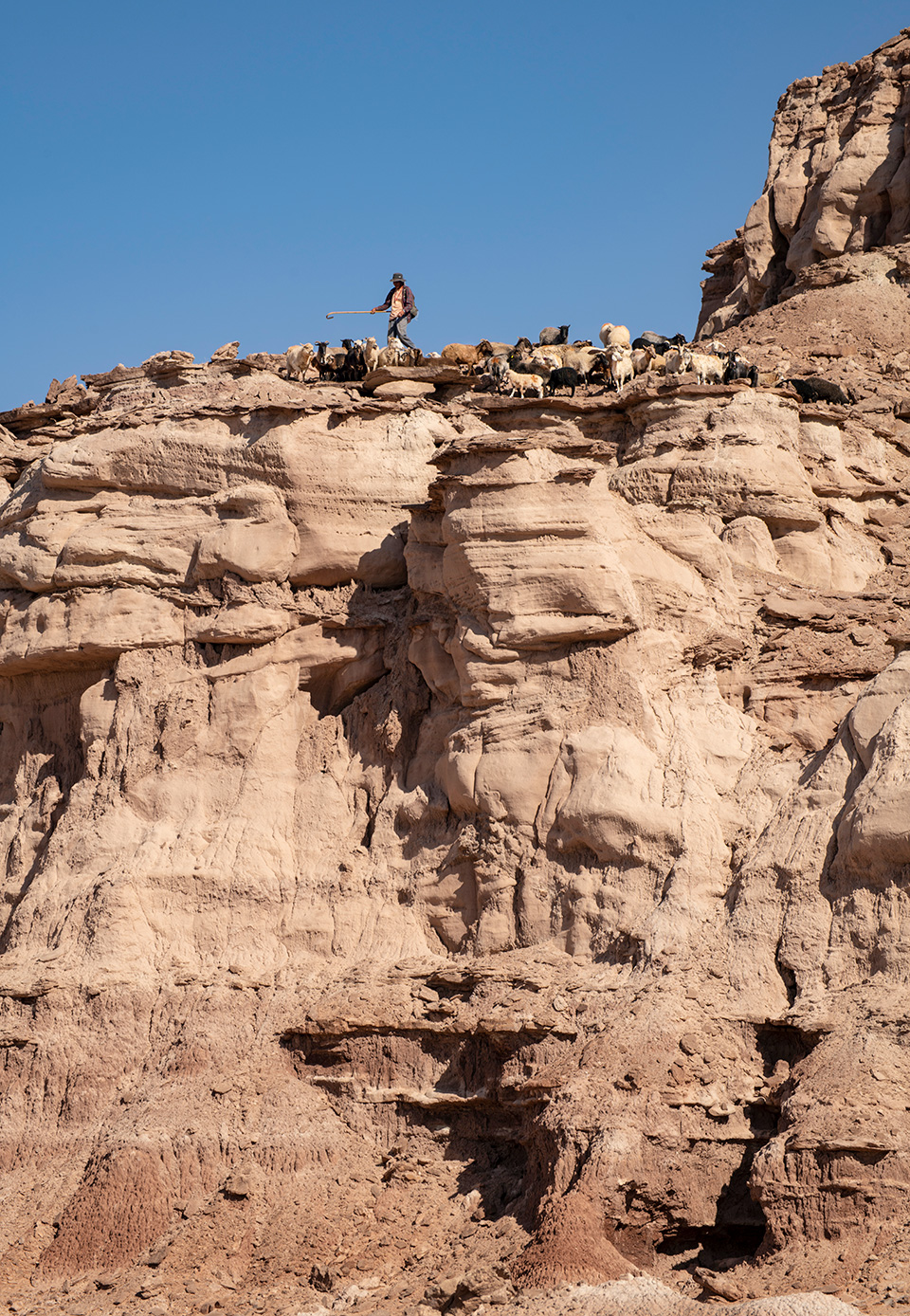
Some Diné believe the sheep were a gift from the Navajo deity Talking God, who made them from clouds and willow branches, with hooves molded from rainbows and their faces taken from the dawn.
As an adolescent, I too learned about the importance of herding sheep. I often took them to graze after school while spending time with Shimá. I would learn to weave and tend to my homework when I returned to her home after school, but when dinnertime approached, she instructed me to take them out to graze. When I went alone, I took a book with me and read aloud, making the flock my audience.
I remember seeing other families doing the same, getting in a final feeding before the sun rested behind the mesas that sat to the west of us. But now, few are out herding, making it a lonely place for the flock, the herder and the land. There are currently only four or five camps, including ours, that remain active atop the Carrizos.
From my uncle, I learned that as a people, having moved away from sheepherding, we have contributed to climate change, because the sheep gave life not just to us as Diné, but also to everything else around us.
“The land we talk about, it knows, it breathes, it’s alive, it misses us,” Roy says. “Some people say where the foliage used to be, there are now tumbleweeds and goatheads. That’s why that’s all that’s growing — because we don’t exist with it anymore. We don’t go over there anymore; we don’t herd our sheep that way. So, the plants that are good for the land and sheep, they just up and left because a lot of them are migratory — they moved.”
Roy’s understanding of the cultural and ecological impact is only part of his motivation to keep the sheep trailing tradition going. When Kady grew old, he could no longer tend to the flock, so he split the grazing permit, with half going to George. But not long after the last trek Christopher and Irvin made from Utah to Arizona 50 years ago, George passed away and Christopher took over. He and his siblings trailed the sheep up the Carrizos for a few years before he left them with Shimá, who eventually took over. When she entered old age, it was Roy who took over.
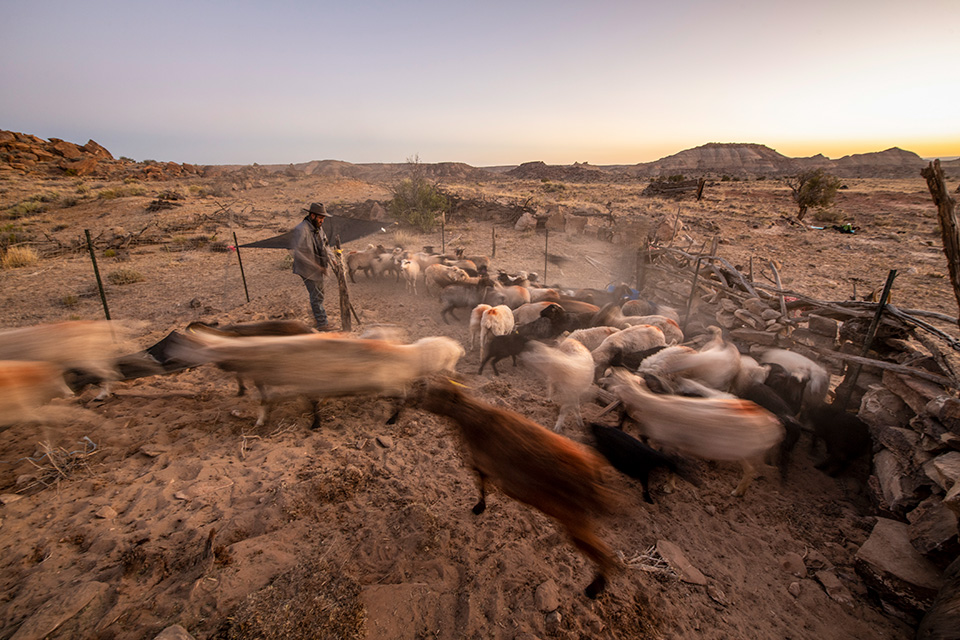
The world was changing, and the world outside of the reservation became more enticing, which left my uncle to make some tough decisions. “I had my frustrations; I had my breakdowns,” Roy recalls. “[Sometimes] I sat in the corral because I didn’t want Shimá to see me cry about it, because my heart, for some reason, was still out there, and also here, because Shimá was at that stage in her life where she was becoming helpless. So, I would sit in the corral and just talk to whoever could listen, which was the livestock. I didn’t want to share that with my mom, because I didn’t want to break her heart. I finally got to where I thought, Hey, this is my life … [and] things just fell into place.”
Since the mid-1980s, Roy has looked after the livestock with and without Shimá. And over the years, he’s taught others to do the same in an effort to revive the practice. In 2022, he made the decision to revive the trail from Utah to Arizona, and with the help of community members and family, he made it happen.
“[We wanted] to reconnect with the land, the space, the environment where they had originated from,” he says. “Also, with that, so the next generation could re-identify themselves and reconnect the same way that the sheep would. That’s one of the main reasons that we decided that we should retrace the sheep trail from Utah, and not knowing that it would be the 50th anniversary as well. That came later.”
Taking part in the trailing was my nephew Tyrrell Tapaha, who has taken on many of the family’s legacies, including Navajo rug weaving. Most recently, Tyrrell has immersed himself in learning the role of herder of the flock that helps supply wool for his work. He’s unexpectedly found himself the keeper of our traditions, which he has taken in stride. He says he understands that many are looking to him to take over the flock, a responsibility he does not take lightly.
“I’m making it a point to be here the past few years … where I set aside my summer months to say, ‘OK, I’m going to be on the mountain,’ ” he says. “Now that I’m in that position, I don’t want to not be here; I have the time to, [and] I have a career path right now that allows that. But I’m just trying to figure out what I want this, for myself, to be. I already know what it means for the people around me [and] what it means for the community, but what does that mean for what I want and my time here?”
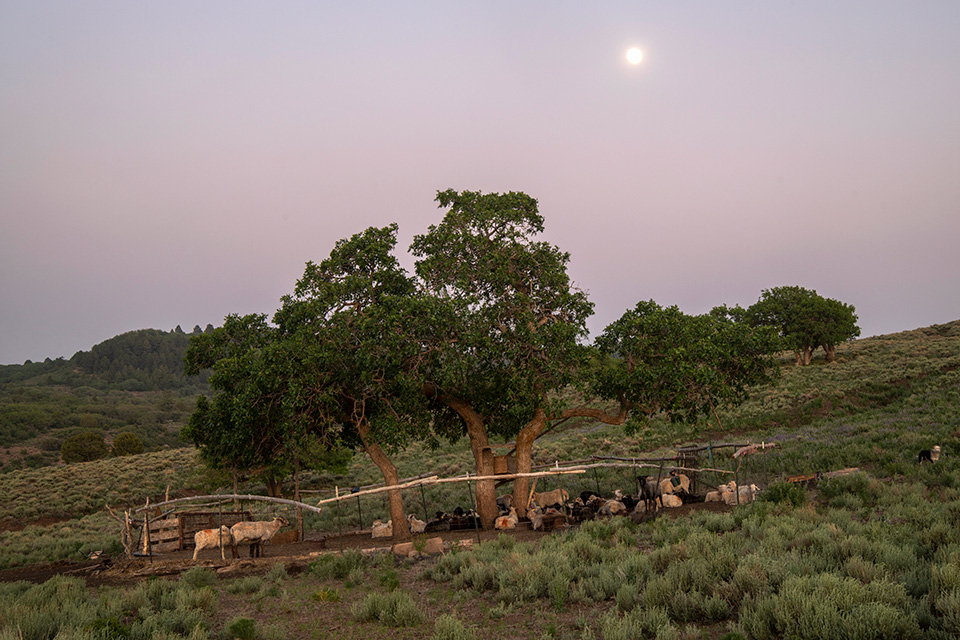
The summer of 1972 brings back many memories for my uncle Christopher, but also emotions and reminders of difficult times. Days after he and Irvin trailed the sheep to the top of the mountains, his father passed away, leaving him to take over and take on a responsibility most 15-year-olds would not be able to endure today. But he says the hardships, experienced during a time when conveniences were few and far between, helped him understand what was important as a Diné. He says he not only hopes future generations will carry on the legacy of herding sheep but also believes they are more than capable of doing so.
“I think a lot of these younger ones can still do it,” he says, “but there are very few willing to do it. For me, I’m thankful that we still have a few that think about those things — that we can still continue to do it and pass that on to our younger generation.”
Christopher has one other hope, a personal one that he thinks about often. Before leaving from the Utah homestead for Arizona 50 years ago, he prayed for the opportunity to return someday. “There’s this one area where there’s a pile of rocks,” he recalls. “I came across that pile of rocks, and I did a small prayer-like thing, saying that I would be leaving the area for some time and that we or I would return someday to continue what has sustained our family all these years. In the Navajo way, I think they call those places tsé ninájihí. I’ve always thought, and I still do think, that I would return to do those things. That’s my hope for the family.”

